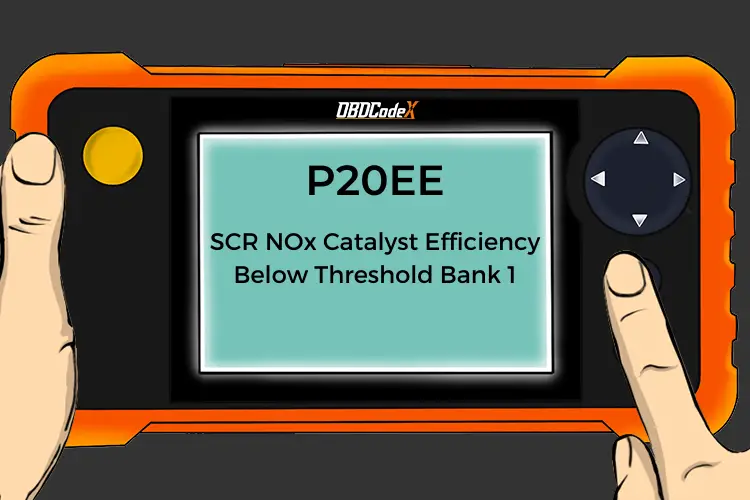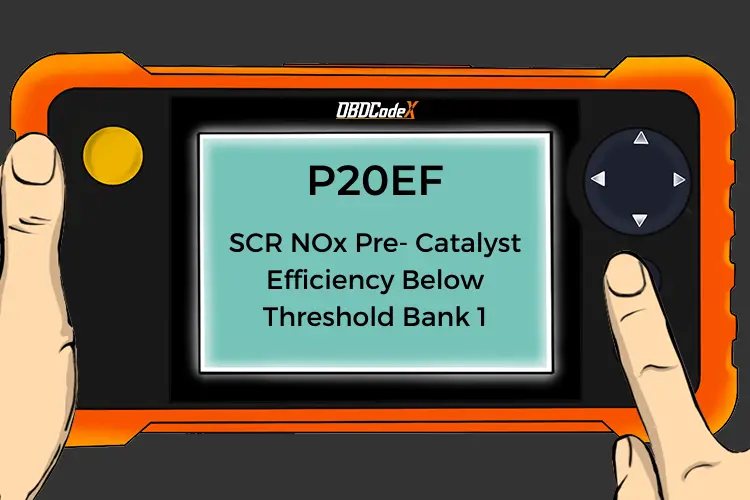P20EC: SCR NOx Catalyst - Over Temperature Bank 1
Is your scanner showing P20EC?
No worries. We'll show you what it means and how to deal with it.
P20EC: SCR NOx Catalyst - Over Temperature Bank 1
OVERVIEWWhat Does The P20EC Code Mean?
When a P20EC is stored in a diesel powered, OBD-II equipped vehicle, it means that the powertrain control module has detected that the temperature for the selective catalyst reduction system (SCR) system exceeds maximum allowable parameters. This particular code applies to the downstream temperature sensor for engine bank one. Bank one is the bank of the engine that contains the number one cylinder.
While modern, clean-burning diesel engines have many advantages over gasoline engines (especially in commercial truck applications), they also tend to produce more of certain harmful exhaust gases than other engines. The most notable of these offensive pollutants are ions of nitrogen oxide (NOx).
Exhaust gas recirculation (EGR) systems help to dramatically reduce NOx but many of today’s powerful diesel engines cannot meet strict federal (U.S.) emission standards using the EGR system alone. For this reason, SCR systems were developed.
SCR systems inject diesel exhaust fluid (DEF) into the exhaust in front of the catalytic converter or the NOx trap. The introduction of DEF raises exhaust gas temperature and allows the catalyst element to perform more efficiently. It makes the catalyst last longer and allows fewer NOx emissions to be released into the atmosphere.
Temperature sensors are placed before and after the catalyst to monitor its temperature and efficiency. The entire SCS system is controlled by either the PCM or a stand-alone controller which interacts with the PCM. EIther way, the controller monitors the temperature sensors (as well as other inputs) to determine the appropriate time for DEF injection. Precise DEF injection is necessary to maintain exhaust temperature within acceptable parameters and promote optimum NOx filtration.
If the PCM detects a catalyst temperature that exceeds maximum allowable parameters, a code P20EC will be stored and a malfunction indicator lamp may be illuminated.
What Are The Symptoms Of The P20EC Code?
Symptoms of a P20EC trouble code may include:
- Excessive black smoke from vehicle exhaust
- Diminished engine performance
- Reduction in fuel efficiency
- Other stored SCR and emission related codes
What Are The Potential Causes Of The P20EC Code?
Causes for this code may include:
- Defective exhaust temperature sensor
- Inoperative SCR system
- Faulty SCR injector
- Incorrect or insufficient DEF fluid
- Bad SCR controller or programming error
- Pre-catalyst exhaust leaks
- Installation of aftermarket or high-performance exhaust components
How Serious Is This P20EC Code?
Any stored SCR related codes may initiate the SCR system being disabled. The stored code P20EC should be considered severe and addressed as quickly as possible. Catalyst damage could result if the code is not rectified quickly.
How Can You Fix The P20EC Code?
If other SCR or exhaust emissions codes or exhaust temperature codes are stored, these should be addressed before attempting to diagnose the stored P20EC.
Any pre-catalyst exhaust leaks should be repaired before attempting a diagnosis for this type of code.
Tools required
Access to a diagnostic scanner, a digital volt/ohmmeter (DVOM), an infrared thermometer with a laser pointer, and a source of vehicle specific SCR system diagnostic information will be required to diagnose a code P20EC.
Locating a technical service bulletin (TSB) that matches the vehicle year, make, and model; as well as the engine size, code/s stored, and symptoms exhibited could yield helpful diagnostic information.
Step-by-step guide
Begin your diagnosis with a visual inspection of the SCR injection system, exhaust temperature sensors, NOx sensors, and oxygen (02) sensor harnesses and connectors. Burnt or damaged wiring and or connectors should be repaired or replaced before proceeding.
Continue by locating the vehicle diagnostic connector and plugging in the scanner. Retrieve all stored codes and pertinent freeze frame data and record this information before clearing the codes. Afterwards, test drive the vehicle until the PCM either enters readiness mode or the code is reset.
If the PCM does enter readiness mode, the code is intermittent and may be much more difficult to diagnose at this time. The conditions which contributed to the code being stored may need to worsen before a diagnosis can be reached.
If the code is reset immediately, search your source of vehicle information to obtain diagnostic flow charts, connector pin out charts, connector face views, along with component testing procedures and specifications. This information will be necessary in completing the next steps of your diagnosis.
Observe the scanner data stream to compare exhaust (pre-cat and post-cat) temperature sensor data between engine banks. If inconsistencies are detected, test the exhaust temperature sensors using the DVOM. Sensors which fail to comply with manufacturer specifications, should be considered defective.
If all sensors and circuitry appear to be functioning as intended, suspect that the catalyst element is faulty or that the SCR system has failed.
Note: Make sure that the DEF reservoir is filled with the appropriate fluid and that it has not been contaminated in any way
Recommended Parts
Below are some recommended auto parts to help you address the trouble code affecting your vehicle and get it running smoothly again:
>>> O2 Sensor
>>> NOx Sensor
>>> Exhaust gas temperature sensor
>>> SCR System
>>> PEAK BlueDEF Diesel Exhaust Fluid
>>> Autel Scanner MaxiCOM MK808S
>>> KAIWEETS Digital Multimeter
>>> Etekcity Infrared Thermometer
Note: During the purchasing process, please check carefully whether the part you want to buy fits your car!
Reference Sources
P20EC SCR NOx Catalyst – Over Temperature Bank 1, OBD-Codes.




